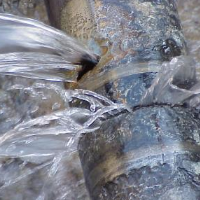Water-Main Burst Highlights L.A.’s $1.3-Billion Problem

If the Los Angeles Times had waited two days, it could have had a spectacularly fresh anecdote to lead its large takeout on L.A.’s looming $1.3-billion bill to retool its oldest and most decrepit water mains.
On Wednesday, a 98-year-old pipe burst in the Hollywood Hills, sending 100,000 gallons of water cascading through streets, cracking sidewalks and submerging cars. Twenty residents were left without power. One inundated garage was said to house a 1954 Triumph, antique furniture and Persian rugs.
The L.A. Times has mapped the city’s aging water infrastructure, applying Department of Water and Power (DWP) grades of “A-F” and cataloguing the costs in both money and water. About one-fifth of the city’s 6,730 miles of pipe date back to 1930 or earlier. Those should all be toast by 2030.
The city spends $44 million a year to replace about 21 miles of pipe but would like to spend about three times that much for the next 10 years to replace 435 miles. About 6% of the city’s pipes are graded “D” or “F” by the DWP. More than 40% of those pipes are at least 85 years old.
The New York Times in September put the cost of doing all the necessary upgrades and repairs to L.A.’s water infrastructure at $3 billion and the cost of all needed public works improvements at $8.1 billion. That last number is also the size of L.A. entire city budget for a year.
The city averages four repairs of leaks a day; about 13,000 since 2006. And that’s just the leaks that get detected and fixed. The L.A. Times said water officials estimate that 8 billion gallons of water are lost every year, enough for 50,000 households.
Many of the leaks are mundane, but some are spectacular. Last summer, 20 million gallons of water washed over Westwood and flooded UCLA’s Pauley Pavilion, when two trunk lines blew on Sunset Boulevard. They were both more than 90 years old, with “C” grades.
Although Southern California is not generally thought of as a locale with conventional seasons, it does have what the DWP calls “leak season,” the time of year when temperatures at night fall into the 30s and 40s. It’s a worthy addition to earthquake season, fire season, the once-feared flood season and the inevitable mudslide season.
–Ken Broder
To Learn More:
Pipe Bursts, Sending 100,000 Gallons into Hollywood Hills Neighborhood (by Sarah Parvini, Matt Stevens and Veronica Rocha, Los Angeles Times)
Infrastructure Cracks as Los Angeles Defers Repairs (by Adam Nagourney, New York Times)
L.A.’s Aging Water Pipes; a $1-Billion Dilemma (by Ben Poston and Matt Stevens, Los Angeles Times)
L.A. Water Main Break Is Spectacular, but Not Unexpected (by Ken Broder, AllGov California)
- Top Stories
- Controversies
- Where is the Money Going?
- California and the Nation
- Appointments and Resignations
- Unusual News
- Latest News
- California Forbids U.S. Immigration Agents from Pretending to be Police
- California Lawmakers Urged to Strip “Self-Dealing” Tax Board of Its Duties
- Big Oil’s Grip on California
- Santa Cruz Police See Homeland Security Betrayal in Use of Gang Roundup as Cover for Immigration Raid
- Oil Companies Face Deadline to Stop Polluting California Groundwater





